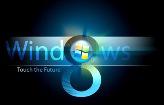 To begin about Windows 8, we must know the changes to the interface of Windows that can outstrip the user like the disappearance of the start button and menu replaced by a start page in the interface called Metro. Here some practical ways for easy manipulation.
To begin about Windows 8, we must know the changes to the interface of Windows that can outstrip the user like the disappearance of the start button and menu replaced by a start page in the interface called Metro. Here some practical ways for easy manipulation.
As in the case of Windows systems, it is useful to use shortcuts to make life easier.
- We can use Windows Key + Print Screen (PrtSc / SysRq) key combination that will capture the screen and save the result directly in the Pictures folder. The file will automatically save in PNG format under the name “Screenshot”.
- Windows Button: Display the Start Screen (Start Menu) or go to the lower left corner of the screen with the mouse to bring up the Start function.
- Windows + D Displays the desktop.
- Windows + C Displays the bar Charms (ability to share, search, and settings).
- Windows + E Display My Computer.
- Windows + F Files search.
- Windows + H Share from the desktop.
- Windows + I Displays the Control Panel, Customizing info, Pc, etc..
- Windows + K Peripheral.
- Windows + L Turns the display to sleep. On wakeup move the mouse to bottom of screen, push left and climb up.
- Windows + M Removes the office windows! but are accessible with a click in the taskbar.
- Windows + P poster features two screen (Windows only, Expand, Duplicate, Second screen only.
- Windows + Q Research shows the Metro.
- Windows + R Display Run.
- Windows + U Ease of Access.
- Windows + W opens in research settings. example of using the File History feature if an external hard drive or USB key plugged.
- Windows + X Displays the functions menu.
- Windows + Z App displays the bar for the application Metro active.
- Windows + Tab Switches the language and keyboard layout between several languages (when configured).
- Windows + Enter Launches the Narrator.
- Windows + Tab Switches for Metro application to another (the desktop, and everything in it, is considered an application Metro).
